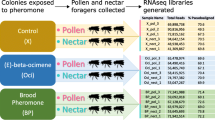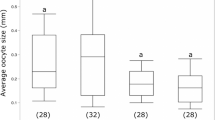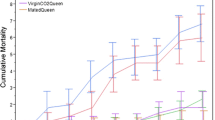Abstract
Responses to social cues, such as pheromones, can be modified by genotype, physiology, or environmental context. Honey bee queens produce a pheromone (queen mandibular pheromone; QMP) which regulates aspects of worker bee behavior and physiology. Forager bees are less responsive to QMP than young bees engaged in brood care, suggesting that physiological changes associated with behavioral maturation modulate response to this pheromone. Since 3′,5′-cyclic guanosine monophosphate (cGMP) is a major regulator of behavioral maturation in workers, we examined its role in modulating worker responses to QMP. Treatment with a cGMP analog resulted in significant reductions in both behavioral and physiological responses to QMP in young caged workers. Treatment significantly reduced attraction to QMP and inhibited the QMP-mediated increase in vitellogenin RNA levels in the fat bodies of worker bees. Genome-wide analysis of brain gene expression patterns demonstrated that cGMP has a larger effect on expression levels than QMP, and that QMP has specific effects in the presence of cGMP, suggesting that some responses to QMP may be dependent on an individual bees’ physiological state. Our data suggest that cGMP-mediated processes play a role in modulating responses to QMP in honey bees at the behavioral, physiological, and molecular levels.




Similar content being viewed by others
Abbreviations
- Amfor :
-
foraging gene
- 8-Br-cGMP:
-
8-Bromo-cGMP, an analog of cGMP
- cGMP:
-
3′,5′-Cyclic guanosine monophosphate
- MDI:
-
Multi-drone inseminated
- 9-ODA:
-
(E)-9-oxodec-2-enoic acid
- PKG:
-
cGMP-dependent protein kinase
- QMP:
-
Queen mandibular pheromone
- qRT-PCR:
-
Quantitative real time PCR
- SDI:
-
Single drone inseminated
- Vg :
-
vitellogenin gene
References
Amdam GV, Simoes ZL, Hagen A, Norberg K, Schroder K, Mikkelsen O, Kirkwood TB, Omholt SW (2004) Hormonal control of the yolk precursor vitellogenin regulates immune function and longevity in honeybees. Exp Gerontol 39(5):767–773. doi:10.1016/j.exger.2004.02.010
Barron A, Schulz D, Robinson GE (2002) Octopamine modulates responsiveness to foraging-related stimuli in honey bees (Apis mellifera). J Comp Phys A 188(8):603–610
Beggs KT, Glendining KA, Marechal NM, Vergoz V, Nakamura I, Slessor KN, Mercer AR (2007) Queen pheromone modulates brain dopamine function in worker honey bees. Proc Natl Acad Sci USA 104(7):2460–2464. doi:10.1073/pnas.0608224104
Belay AT, Scheiner R, So AK, Douglas SJ, Chakaborty-Chatterjee M, Levine JD, Sokolowski MB (2007) The foraging gene of Drosophila melanogaster: spatial-expression analysis and sucrose responsiveness. J Comp Neurol 504(5):570–582. doi:10.1002/cne.21466
Ben-Shahar Y, Robichon A, Sokolowski MB, Robinson GE (2002) Influence of gene action across different time scales on behavior. Science 296(5568):741–744. doi:10.1126/science.1069911296/5568/741
Ben-Shahar Y, Leung HT, Pak WL, Sokolowski MB, Robinson GE (2003) cGMP-dependent changes in phototaxis: a possible role for the foraging gene in honey bee division of labor. J Exp Biol 206(Pt 14):2507–2515
Bloch G, Toma DP, Robinson GE (2001) Behavioral rhythmicity, age, division of labor and period gene expression in the honey bee brain. J Biol Rhythms 16(5):444–456
Dennis G Jr, Sherman BT, Hosack DA, Yang J, Gao W, Lane HC, Lempicki RA (2003) DAVID: database for annotation, visualization, and integrated discovery. Genome Biol 4(5):P3
Fischer P, Grozinger CM (2008) Pheromonal regulation of starvation resistance in honey bee workers (Apis mellifera). Naturwissenschaften 95(8):723–729. doi:10.1007/s00114-008-0378-8
Fluri P, Lüscher M, Wille H, Gerig L (1982) Changes in weight of the pharyngeal gland and haemolymph titres of juvenile hormone, protein and vitellogenin in worker honey bees. J Insect Physiol 28(1):61–68
Fujiwara M, Sengupta P, McIntire SL (2002) Regulation of body size and behavioral state of C elegans by sensory perception and the EGL-4 cGMP-dependent protein kinase. Neuron 36(6):1091–1102. doi:S0896627302010930
Fussnecker B, Grozinger C (2008) Dissecting the role of Kr-h1 brain gene expression in foraging behavior in honey bees (Apis mellifera). Insect Mol Biol 17(5):515–522. doi:10.1111/j.1365-2583.2008.00819.x
Gadenne C, Anton S (2000) Central processing of sex pheromone stimuli is differentially regulated by juvenile hormone in a male moth. J Insect Physiol 46(8):1195–1206
Gadenne C, Renou M, Sreng L (1993) Hormonal control of pheromone responsiveness in the male black cutworm, Agrotis ipsilon. Cell Mol Life Sci 49(8):721–724
Grozinger C, Robinson G (2007) Endocrine modulation of a pheromone-responsive gene in the honey bee brain. J Comp Physiol A 193(4):461–470
Grozinger CM, Sharabash NM, Whitfield CW, Robinson GE (2003) Pheromone-mediated gene expression in the honey bee brain. Proc Natl Acad Sci USA 100(Suppl 2):14519–14525. doi:10.1073/pnas.2335884100
Grozinger CM, Fischer P, Hampton JE (2007) Uncoupling primer and releaser responses to pheromone in honey bees. Naturwissenschaften 94(5):375–379. doi:10.1007/s00114-006-0197-8
Higo HA, Colley SJ, Winston ML, Slessor KN (1992) Effects of honey bee (Apis mellifera L.) queen mandibular gland pheromone on foraging and brood rearing. Can Entomol 124(2):409–418
Hou Y, Ye RD, Browning DD (2004) Activation of the small GTPase Rac1 by cGMP-dependent protein kinase. Cell Signal 16(9):1061–1069. doi:10.1016/j.cellsig.2004.03.002
Huang DW, Sherman BT, Lempicki RA (2009) Systematic and integrative analysis of large gene lists using DAVID bioinformatics resources. Nat Protoc 4(1):44–57. doi:10.1038/nprot.2008.211
Ingram KK, Oefner P, Gordon DM (2005) Task-specific expression of the foraging gene in harvester ants. Mol Ecol 14(3):813–818. doi:10.1111/j.1365-294X.2005.02450.x
Jaycox ER (1970) Honey bee foraging behavior: responses to queens, larvae, and extracts of larvae. Ann Entomol Soc Am 63:1689–1694
Johnson BR (2010) Division of labor in honeybees: form, function, and proximate mechanisms. Behav Ecol Sociobiol 64(3):305–316. doi:10.1007/s00265-009-0874-7
Kaun KR, Hendel T, Gerber B, Sokolowski MB (2007a) Natural variation in Drosophila larval reward learning and memory due to a cGMP-dependent protein kinase. Learn Mem 14(5):342–349. doi:10.1101/lm.505807
Kaun KR, Riedl CA, Chakaborty-Chatterjee M, Belay AT, Douglas SJ, Gibbs AG, Sokolowski MB (2007b) Natural variation in food acquisition mediated via a Drosophila cGMP-dependent protein kinase. J Exp Biol 210(Pt 20):3547–3558. doi:10.1242/jeb.006924
Kocher SD, Ayroles JF, Stone EA, Grozinger CM (2011) Individual variation in pheromone response correlates with reproductive traits and brain gene expression in worker honey bees. PLoS ONE 5(2):e9116. doi:10.1371/journal.pone.0009116
König C, Schmid-Hempel P (1995) Foraging activity and immunocompetence in workers of the bumble bee, Bombus terrestris L. Proc Biol Sci 260(1358):225–227
Laidlaw H Jr (1987) Instrumental insemination of honey bee queens: its origin and development. Bee World 68:17–38
Linn CE Jr, Roelofs WL (1984) Sublethal effects of neuroactive compounds on pheromone response thresholds in male oriental fruit moths. Arch Insect Biochem Physiol 1:331–344
Linn CE Jr, Campbell MG, Roelofs WL (1986) Male moth sensitivity to multicomponent pheromones: critical role of female-released blend in determining the functional role of components and active space of the pheromone. J Chem Ecol 12(3):659–668
Linn CE Jr, Campbell MG, Roelofs WL (1992) Photoperiod cues and the modulatory action of octopamine and 5-hydroxytryptamine on locomotor and pheromone response in male gypsy moths, Lymantria dispar. Arch Insect Biochem Physiol 20(4):265–284
Linn CE Jr, Campbell MG, Poole KR, Wu WQ, Roelofs WL (1996) Effects of photoperiod on the circadian timing of pheromone response in male Trichoplusia ni: relationship to the modulatory action of octopamine. J Insect Physiol 42(9):881–891
Mery F, Belay AT, So AK, Sokolowski MB, Kawecki TJ (2007) Natural polymorphism affecting learning and memory in Drosophila. Proc Natl Acad Sci USA 104(32):13051–13055. doi:10.1073/pnas.0702923104
Morley JE, Kumar VB, Mattammal MB, Farr S, Morley PM, Flood JF (1996) Inhibition of feeding by a nitric oxide synthase inhibitor: effects of aging. Eur J Pharmacol 311(1):15–19. doi:0014299996005468
Morley JE, Alshaher MM, Farr SA, Flood JF, Kumar VB (1999) Leptin and neuropeptide Y (NPY) modulate nitric oxide synthase: further evidence for a role of nitric oxide in feeding. Peptides 20(5):595–600. doi:S0196-9781(99)00012-1
Pankiw T, Winston ML, Slessor KN (1994) Variation in worker response to honey bee (Apis mellifera L.) queen mandibular pheromone (Hymenoptera: Apidae). J Insect Behav 7(1):1–15
Pankiw T, Huang Z-Y, Winston ML, Robinson GE (1998) Queen mandibular gland pheromone influences worker honey bee (Apis mellifera L.) foraging ontogeny and juvenile hormone titers. J Insect Physiol 44(7–8):685–692. pii:S0022191098000407
Pereira HS, Sokolowski MB (1993) Mutations in the larval foraging gene affect adult locomotory behavior after feeding in Drosophila melanogaster. Proc Natl Acad Sci USA 90(11):5044–5046
Pham-Delegue MH, Trouiller E, Bakchine E, Roger B, Masson C (1993) Age dependency of worker bee responses to queen pheromone in a four-armed olfactometer. Ins Sociaux 38(3):283–292. doi:10.1007/BF01314914
Pophof B (2000) Octopamine modulates the sensitivity of silkmoth pheromone receptor neurons. J Comp Physiol A 186(3):307–313
Robertson HM, Wanner KW (2006) The chemoreceptor superfamily in the honey bee, Apis mellifera: expansion of the odorant, but not gustatory, receptor family. Genome Res 16(11):1395–1403. doi:10.1101/gr.5057506
Robinson GE (1987) Regulation of honey bee age polyethism by juvenile hormone. Behav Ecol Sociobiol 20(5):329–338
Sachse S, Rappert A, Galizia CG (1999) The spatial representation of chemical structures in the antennal lobe of honeybees: steps towards the olfactory code. Eur J Neurosci 11(11):3970–3978
Scheiner R, Sokolowski MB, Erber J (2004) Activity of cGMP-dependent protein kinase (PKG) affects sucrose responsiveness and habituation in Drosophila melanogaster. Learn Mem 11(3):303–311. doi:10.1101/lm.7160411/3/303
Schulz DJ, Robinson GE (2001) Octopamine influences division of labor in honey bee colonies. J Comp Physiol A 187(1):53–61
Slessor KN, Kaminski L-A, King GGS, Borden JH, Winston ML (1988) Semiochemical basis of the retinue response to queen honey bees. Nature 332(6162):354–356
Slessor KN, Winston ML, Le Conte Y (2005) Pheromone communication in the honeybee (Apis mellifera L.). J Chem Ecol 31(11):2731–2745. doi:10.1007/s10886-005-7623-9
Toth AL, Kantarovich S, Meisel AF, Robinson GE (2005) Nutritional status influences socially regulated foraging ontogeny in honey bees. J Exp Biol 208(Pt 24):4641–4649. doi:10.1242/jeb.01956
Touhara K, Vosshall LB (2009) Sensing odorants and pheromones with chemosensory receptors. Annu Rev Physiol 71:307–332. doi:10.1146/annurev.physiol.010908.163209
Wang Z, Pan Y, Li W, Jiang H, Chatzimanolis L, Chang J, Gong Z, Liu L (2008) Visual pattern memory requires foraging function in the central complex of Drosophila. Learn Mem 15(3):133–142. doi:10.1101/lm.873008
Wanner KW, Nichols AS, Walden KK, Brockmann A, Luetje CW, Robertson HM (2007) A honey bee odorant receptor for the queen substance 9-oxo-2-decenoic acid. Proc Natl Acad Sci USA 104(36):14383–14388. doi:10.1073/pnas.0705459104
Whitfield CW, Ben-Shahar Y, Brillet C, Leoncini I, Crauser D, Leconte Y, Rodriguez-Zas S, Robinson GE (2006) Genomic dissection of behavioral maturation in the honey bee. Proc Natl Acad Sci USA 103(44):16068–16075. doi:10.1073/pnas.0606909103
Wyatt TD (2003) Pheromones and animal behaviour: communication by smell and taste. Cambridge University Press, New York
Xu P, Atkinson R, Jones DN, Smith DP (2005) Drosophila OBP LUSH is required for activity of pheromone-sensitive neurons. Neuron 45(2):193–200. doi:10.1016/j.neuron.2004.12.031
Zhukovskaya MI, Kapitsky SV (2006) Activity modulation in cockroach sensillum: the role of octopamine. J Insect Physiol 52(1):76–86. doi:10.1016/j.jinsphys.2005.09.005
Acknowledgments
We would like to thank S. Kocher for advice on the microarray analyses, J. Flowers for expert beekeeping assistance, T. Crowgey and H. Yamamoto for assistance with the behavioral assays, and the rest of the Grozinger lab for insightful comments and helpful discussions. This research was supported by an NIH-NIDCD grant to G.E. Robinson (subcontract to C.M.G.) and an NSF CAREER grant to C.M.G. Animal care and collection of data was in accordance with US laws. The authors declare no competing interests.
Author information
Authors and Affiliations
Corresponding author
Electronic supplementary material
Below is the link to the electronic supplementary material.
Rights and permissions
About this article
Cite this article
Fussnecker, B.L., McKenzie, A.M. & Grozinger, C.M. cGMP modulates responses to queen mandibular pheromone in worker honey bees. J Comp Physiol A 197, 939–948 (2011). https://doi.org/10.1007/s00359-011-0654-5
Received:
Revised:
Accepted:
Published:
Issue Date:
DOI: https://doi.org/10.1007/s00359-011-0654-5




